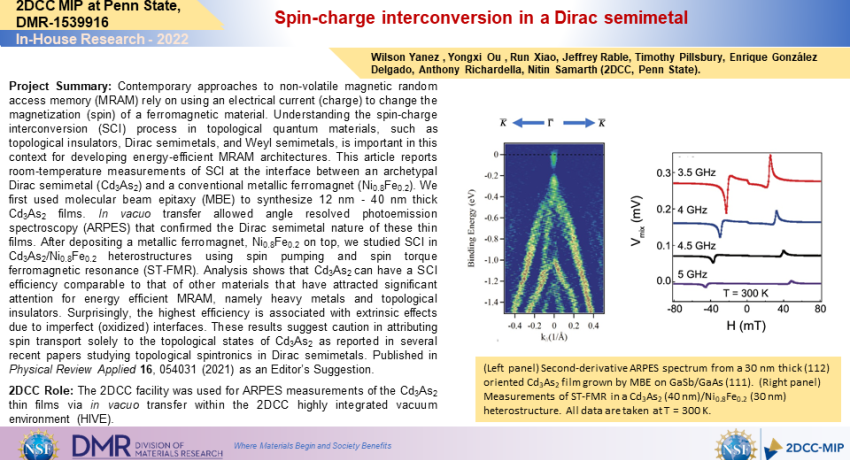Project Summary: Contemporary approaches to non-volatile magnetic random access memory (MRAM) rely on using an electrical current (charge) to change the magnetization (spin) of a ferromagnetic material. Understanding the spin-charge interconversion (SCI) process in topological quantum materials, such as topological insulators, Dirac semimetals, and Weyl semimetals, is important in this context for developing energy-efficient MRAM architectures. This article reports room-temperature measurements of SCI at the interface between an archetypal Dirac semimetal (Cd3As2) and a conventional metallic ferromagnet (Ni0.8Fe0.2). We first used molecular beam epitaxy (MBE) to synthesize 12 nm - 40 nm thick Cd3As2 films. In vacuo transfer allowed angle resolved photoemission spectroscopy (ARPES) that confirmed the Dirac semimetal nature of these thin films. After depositing a metallic ferromagnet, Ni0.8Fe0.2 on top, we studied SCI in Cd3As2/Ni0.8Fe0.2 heterostructures using spin pumping and spin torque ferromagnetic resonance (ST-FMR). Analysis shows that Cd3As2 can have a SCI efficiency comparable to that of other materials that have attracted significant attention for energy efficient MRAM, namely heavy metals and topological insulators. Surprisingly, the highest efficiency is associated with extrinsic effects due to imperfect (oxidized) interfaces. These results suggest caution in attributing spin transport solely to the topological states of Cd3As2 as reported in several recent papers studying topological spintronics in Dirac semimetals. Published in Physical Review Applied 16, 054031 (2021) as an Editor’s Suggestion.
2DCC Role: The 2DCC facility was used for ARPES measurements of the Cd3As2 thin films via in vacuo transfer within the 2DCC highly integrated vacuum environment (HIVE).
What Has Been Achieved: We used MBE to Dirac semimetal/ferromagnet metal (Cd3As2/Ni0.8Fe0.2) heterostructures and measured spin-charge interconversion using spin pumping and spin torque ferromagnetic resonance. Importance of the Achievement: This work showed efficient spin-charge interconversion in a Dirac semimetal and revealed a surprising enhancement in the interconversion efficiency with an oxidized interface.
Unique Feature(s) of the MIP that Enabled this Achievement: the 2DCC HIVE was integral to proving the Dirac semimetal nature of the MBE-grown Cd3As2 films.
Publication:
Wilson Yanez , Yongxi Ou , Run Xiao , Jahyun Koo, Jacob T. Held , Supriya Ghosh, Jeffrey Rable, Timothy Pillsbury, Enrique González Delgado, Kezhou Yang, Juan Chamorro, Alexander J. Grutter, Patrick Quarterman, Anthony Richardella, Abhronil Sengupta, Tyrel McQueen, Julie A. Borchers, K. Andre Mkhoyan, Binghai Yan, and Nitin Samarth, Physical Review Applied 16, 054301 (2021).
DOI: 10.1103/physrevapplied.16.054031
The principal support for this project was provided by SMART, one of seven centers of nCORE, a Semiconductor Research Corporation program, sponsored by the National Institute of Standards and Technology (NIST). This supported the synthesis and standard characterization of Py/Cd3As2 heterostructures as well as spin-charge interconversion measurements (WY, YO, NS) and their characterization using STEM (JH, SG, AM). Additional support for materials synthesis was provided by the Institute for Quantum Matter under DOE EFRC grant DE-SC0019331 (RX, JC, NS, TM). The Penn State Two-Dimensional Crystal Consortium- Materials Innovation Platform (2DCC-MIP) under NSF Grant No. DMR-1539916 provided support for ARPES measurements (YO, TP, AR, NS). The magnetometry measurements were carried out by JR, supported by a grant from the University of Chicago. Part of this work was car- ried out in the College of Science and Engineering Characterization Facility, University of Minnesota, which has received capital equipment funding from the National Science Foundation through the UMN MRSEC under Award Number DMR-2011401 (JH, SG, AM). EG acknowledges support for an undergraduate summer internship from the Office of Graduate Educational Equity Programs and Eberly College of Science at the Pennsylvania State University. B.Y. acknowledges the financial support by the European Research Council (ERC Consolidator Grant No. 815869). Certain commercial equipment, instruments, or materials (or suppliers, or software, etc.) are identified in this paper to foster understanding. Such identification does not imply recommendation or endorsement by the National Institute of Standards and Technology, nor does it imply that the materials or equipment identified are necessarily the best available for the purpose.
